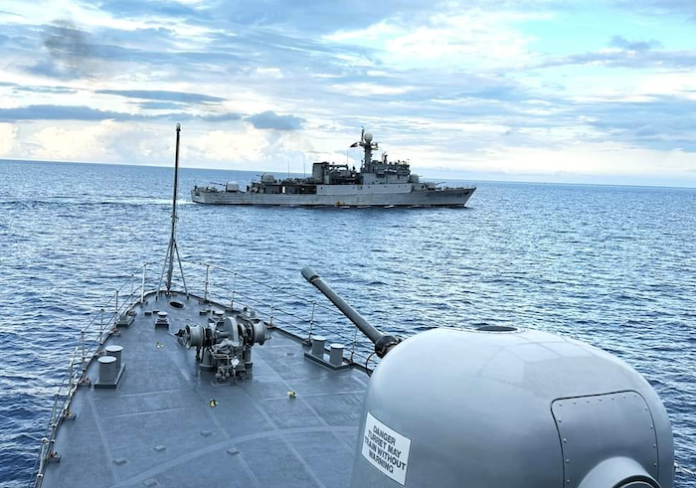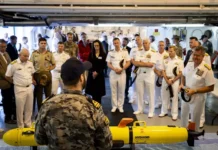
By Jennifer Parker*
A key step in preventing conflict is acknowledging the risk. Former Australian prime minister Paul Keating’s assertion this week that Senator Penny Wong’s speech highlighting the risk of a conflict was intended to be “rattling” for China is wide of the mark and dangerous.
Although China’s behaviour in the region was not directly mentioned in the major keynotes or the leaders’ statement at the ASEAN-Australia special summit held in Melbourne this week, the topic was omnipresent.
Reinforced by the images of Tuesday’s bullying behaviour from Chinese Coast Guard vessels towards vessels from the Philippines. A coincidental incident, or perhaps signalling from Beijing to the leaders attending the summit.
Either way, China’s actions on the seas and in the skies above the South China Sea are undermining key principles of international law. Principles that have underwritten both Australia’s and the region’s recent peace and prosperity leading to what Senator Wong rightly characterised as the “most confronting circumstances in our region in decades” – a point Keating seems to gloss over in his erratic critique of Wong.
A conflict in the region would be catastrophic. If Australia were to be involved, which may well be unavoidable, such a conflict would result in the significant loss of life of our servicewomen and men. It would also generate a fundamental shift in the average Australian’s way of life as Australia’s maritime trade is restricted.
It is in this vein that conflict prevention was rightly a major theme of the Australian foreign minister’s keynote speech at this week’s ASEAN-Australia special summit.
Unsafe interactions
How might conflict in the region arise? There are several flashpoints, but one of the most urgent is the growing number of incidents between ships and aircraft in the region, driven by displays of aggression and unprofessionalism from China’s military ships and aircraft. This was made plain in the 2023 release of Pentagon imagery documenting nearly 200 unsafe interactions between US and People’s Liberation Army Air Force pilots between September 2021 and October 2023.
Australian ships and aircraft have also been subject to this behaviour. It was just under two years ago that a Chinese fighter jet deployed metal fragments in the form of chaff into the engines of an Australian maritime patrol aircraft. Less than six months ago a Chinese destroyer aggressively approached HMAS Toowoomba, injuring two of its sailors whilst Toowoomba conducted diving operations. These reckless actions could lead to a miscalculation.
In the media surrounding this week’s ASEAN-Australia special summit the president of the Philippines, Ferdinand Marcos jr has been front and centre. On the topic of a conflict in the region, Marcos has been clear that a regional conflict could arise by accident, a miscalculation with significant unintended consequences. Marcos’ words in a television interview on Monday night were almost prescient, as on Tuesday imagery once again emerged of Chinese Coast Guard ships aggressively blockading Philippine vessels within the Philippines’ exclusive economic zone.
Like clockwork, China again ramped up its aggressive actions in the West Philippine Sea attempting to stop a contracted Philippine resupply vessel from reaching Second Thomas Shoal.
The dangerous manoeuvres resulted in a minor collision between Chinese Coast Guard and Philippines’ Coast Guard vessels. Compounding the aggressive tactics, two Chinese Coast Guard Vessels directed water cannons onto the much smaller wooden resupply vessel, shattering the bridge windows and causing minor injuries to four crew members on board. Thankfully the injuries were minor, but what if they had been more serious? Could this have been the spark that ignites a regional conflict?
‘Preventive architecture’
So how do we avoid an accidental incident between ships or aircraft sparking an unintended regional conflict? Australia and ASEAN can do this by working to establish measures of incident avoidance and crisis management. As Senator Wong articulated we must work to establish a “preventive architecture to increase resilience and reduce the risk of conflict through misunderstanding or miscalculation”. Marcos made similar calls seeking a direct communications line with China to manage crises as they emerge. Confidence building and preventive mechanisms like those effectively employed between the United States and Russia during the Cold War are crucial to avoiding an accidental escalation. However, this work must be underpinned by the effective implementation of Australia’s deterrence strategy.
The 2023 Defence Strategic Review highlighted the essential nature of statecraft to Australia’s strategy of deterrence. This week’s ASEAN summit was in many ways a good example of adept statecraft complementing Australia’s defence strategy, but to ensure effective deterrence we must go further.
In responding to China’s continued aggression in the vicinity of Second Thomas Shoal, we must employ a similar escalation in diplomatic responses. This week’s incident – the overt aggression of two Chinese Coast Guard vessels water cannoning a wooden Philippines resupply vessel – calls for a higher level of response.
Whilst there were many positive takeaways from this week’s ASEAN-Australia special summit, the timing of the Chinese Coast Guard incident, the lack of acknowledgement of the incident or reinforcement of the 2016 arbitral tribunal in the leaders’ statement, albeit largely expected, leaves a shadow over the summit. It is time for Senator Wong to directly address China’s actions this week.
To reduce the risk of regional conflict arising because of a miscalculation between ships and aircraft, not only must we focus on increasing the risk reduction architecture in the region, but we must underwrite our strategy of deterrence by clearly articulating that China’s aggression towards the Philippines this week was unacceptable.
*Jennifer Parker is an expert associate with the ANU’s National Security College, and an adjunct fellow in naval studies at UNSW Canberra who has spent over 20 years in the Australian Department of Defence.
This article first appeared in The Australian Financial Review.



